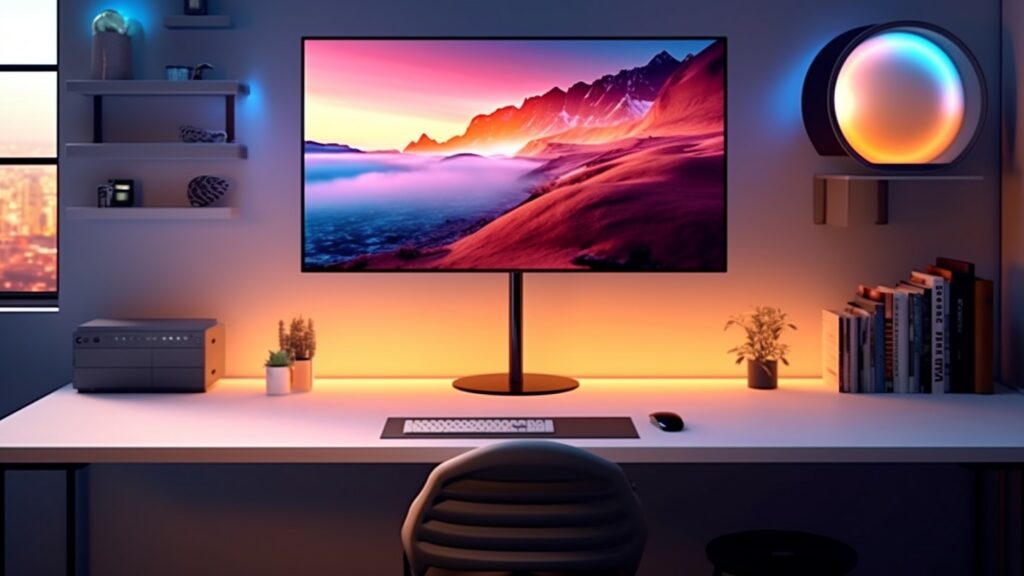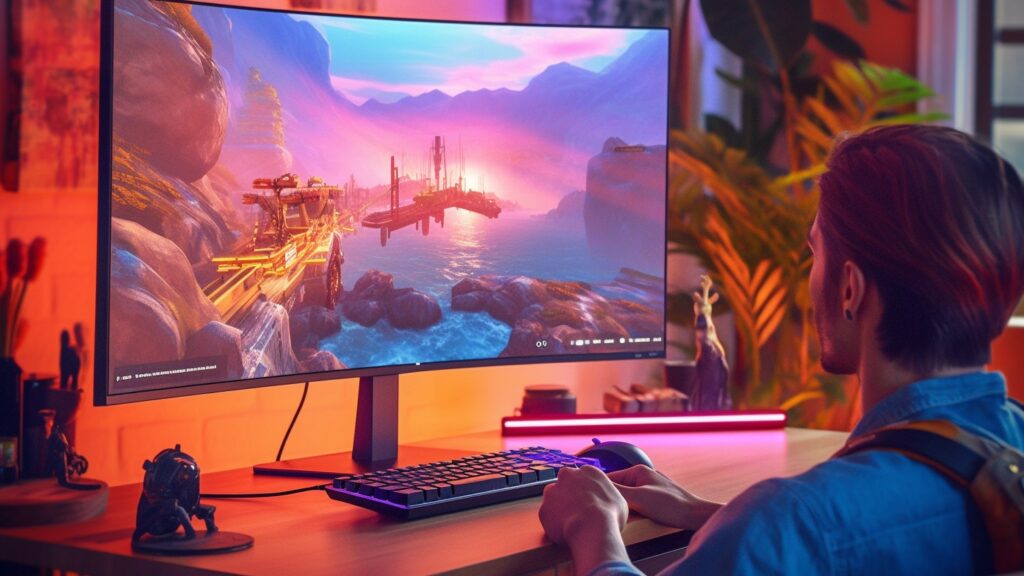Discover the wonderful world of G-Sync and FreeSync with USB-C (USB type-C).

Once upon a time, your desk was cluttered with cables, searching for the right connector for your monitor, and battling tearing and stuttering while gaming. That time is over! In this age of USB-C, G-Sync and FreeSync, everything changes. In this article I answer the question “Do G-Sync and FreeSync work with USB-C?“
I also discuss how these technologies make your life a lot easier and more enjoyable. Read on to discover how to put together the ideal combination of devices for a seamless gaming or movie experience.
Key points summarized:
- G-Sync and FreeSync work with USB-C via DisplayPort Alternate Mode, which ensures smooth images and a better gaming experience.
- Compatibility between USB-C, G-Sync and FreeSync depends on the specifications of your monitor, PC and cables.
- Always check the specifications of your devices and use the correct cable to avoid compatibility issues.
USB-C and the world of image synchronization
Almost all my devices have USB-C. That is not surprising, because as a tech geek I like to buy the best of the best, and believe me: USB-C connections are part of that.
USB-C, the latest connection on the market, has turned the world of image synchronization upside down. Why? Because it not only ensures faster data transfer and charging, but also offers the possibility to connect displays with just one cable.
The advantages of USB-C are countless. Think of the reversibility (no more fiddling with inserting the plug in the right way) and the support for multiple protocols, such as DisplayPort and HDMI. This makes connecting screens and peripherals a lot easier.
The evolution of USB-C has had a significant impact on the PC and monitor industry. More and more laptops, tablets and even smartphones are equipped with USB-C ports. Monitors with USB-C connections are also becoming more common, making for a streamlined, efficient work and play environment.
Do you want to enjoy the possibilities of USB-C just like me? Like using G-Sync or FreeSync with USB-C? Then read on. 😉

What exactly are G-Sync and FreeSync?
G-Sync and FreeSync are technologies that take image synchronization to the next level. They ensure that the images on your screen are displayed more smoothly and without tearing or stuttering.️ 👌
G-Sync was developed by Nvidia and mainly works with their graphics cards. FreeSync, on the other hand, is an open standard from AMD and has been supported by a wider range of manufacturers.
Both technologies aim to synchronize the refresh rate of your monitor with the frames your graphics card produces. This gives you a smoother image and a better gaming experience, as with the best gaming monitor.
While they basically serve the same purpose, there are some differences between G-Sync and FreeSync. For example, G-Sync is known for its consistent performance and quality control, while FreeSync is generally cheaper and more accessible.
How do G-Sync and FreeSync work?
G-Sync and FreeSync work with USB-C using DisplayPort Alternate Mode. This mode enables USB-C to transmit DisplayPort signals, enabling your PC and monitor to use image synchronization technologies such as G-Sync and FreeSync.
To use G-Sync and FreeSync with USB-C, your equipment must meet some requirements. First, your PC should have a USB-C port that supports DisplayPort Alternate Mode.
In addition, it is important that your monitor has both a USB-C input and is compatible with G-Sync or FreeSync. An example of such a compatible configuration is an ultrawide monitor with USB-C connection and FreeSync support.
The role of DisplayPort Alternate Mode in USB-C
DisplayPort Alternate Mode (Alt Mode) is a feature that allows USB-C to support the DisplayPort standard. This means that you can send both video and audio signals to your monitor with one USB-C cable, resulting in a tidier desk.
Using DisplayPort Alt Mode with usb-c offers many benefits, such as higher resolutions, faster refresh rates and the ability to drive multiple displays at the same time.
But more importantly, DisplayPort Alt Mode enables G-Sync and FreeSync compatibility. If you ask yourself “what is VRR (variable refresh rate) and how does it work with USB-C?” Then DisplayPort Alt Mode is the answer.
Compatibility between USB-C, G-Sync and FreeSync
The compatibility between USB-C, G-Sync and FreeSync is affected by several factors, such as the specifications of your monitor and PC. It is important to note that not all usb-c ports support DisplayPort Alternate Mode, and not all monitors with USB-C input support G-Sync or FreeSync. 💻
When using USB-C with G-Sync and FreeSync, you may encounter some limitations and issues, such as your monitor limiting your fps.
To avoid compatibility issues, it is important to choose the right equipment and configurations . Always check the specifications of your devices and make sure they meet the requirements for G-Sync or FreeSync over USB-C.
What you need to know about compatible monitors and PCs
When choosing a monitor, it is important to pay attention to specifications such as G-Sync/FreeSync support and USB-C connections. A good choice, for example, is a 144Hz monitor with USB-C input and G-Sync support.
To check your PC’s compatibility with USB-C, G-Sync, and FreeSync, first make sure your PC has a USB-C port that supports DisplayPort Alternate Mode. In addition, your PC must also have a graphics card that supports G-Sync or FreeSync.
When choosing the right hardware and accessories , such as the best monitor for working from home , or a good gaming monitor (because a gaming monitor increases your fps ), it is important to take into account the compatibility between USB-C, G-Sync and FreeSync.
Look for devices that meet the requirements for these technologies and make sure your PC and monitor are properly connected.
1. Look for the correct specifications on your monitor
When choosing a monitor, it is essential to pay attention to specifications such as:
- G-Sync/FreeSync support
- USB-C connections
It is important to check the monitor manual and product specifications to make sure your monitor is compatible with G-Sync or FreeSync over USB-C.️
2. Check the USB-C ports on your PC
To check if your PC supports USB-C with DisplayPort Alternate Mode, check your PC’s specifications or contact the manufacturer.
The different versions of USB-C affect compatibility with G-Sync and FreeSync. For example, an older version of USB-C may not offer the full functionality of G-Sync or FreeSync. It is therefore important to be aware of the USB-C standard that your PC uses.
Potential problems and solutions
Sometimes there are some bumps in the road when using USB-C with G-Sync and FreeSync. Let’s identify some common problems and discuss practical solutions.

First of all, it is possible that your monitor does not automatically synchronize with your PC. Here it is an option to manually set the monitor to the correct mode (G-Sync or FreeSync) via your monitor’s OSD (On-Screen Display) menu.
If this doesn’t work, make sure you have the latest graphics drivers installed and that your USB-C cable meets DisplayPort Alternate Mode specifications.
In addition, the image quality may not be optimal, such as flickering or screen loss. The cause may be a bad USB-C cable or a power problem.
Try a different, higher quality cable and make sure your monitor and PC are properly connected to a reliable power source.
Different versions of USB-C and their influence
USB-C has had several versions over the years, which affects compatibility with G-Sync and FreeSync. The first versions of USB-C had limited bandwidth and did not always support DisplayPort Alternate Mode. Because of this, they caused problems when synchronizing with G-Sync and FreeSync.
Fortunately, the newer versions of USB-C, such as USB 3.1 Gen 2 and USB 3.2, have been optimized for better compatibility with image sync technologies. These versions offer higher bandwidth and support DisplayPort Alternate Mode, resulting in a smoother experience with G-Sync and FreeSync.
Intel and the role of Adaptive Sync
Intel has also entered the world of image synchronization with its Adaptive Sync technology. Intel Adaptive Sync uses the VESA Adaptive Sync standard, which is also the basis for AMD’s FreeSync.
In terms of compatibility with USB-C and DisplayPort Alternate Mode, Intel Adaptive Sync is capable of working with these technologies if your PC and monitor have the correct specifications.
It is important to note that Intel Adaptive Sync only works with certain Intel graphics cards, such as the Intel Iris Plus Graphics and newer models.
Conclusion: do G-Sync and FreeSync work with USB-C?

The answer is yes, G-Sync and FreeSync work with USB-C, provided you have the right hardware and specifications. 🎉
It is crucial to ensure compatible PCs and monitors and to keep up to date with the latest USB-C versions and DisplayPort Alternate Mode specifications. Remember that an optimal experience with G-Sync and FreeSync depends on the right combination of hardware, cables and settings.
When you’re ready to take your gaming or movie experience to the next level, make sure you choose the right equipment and enjoy smooth, synchronized visuals!